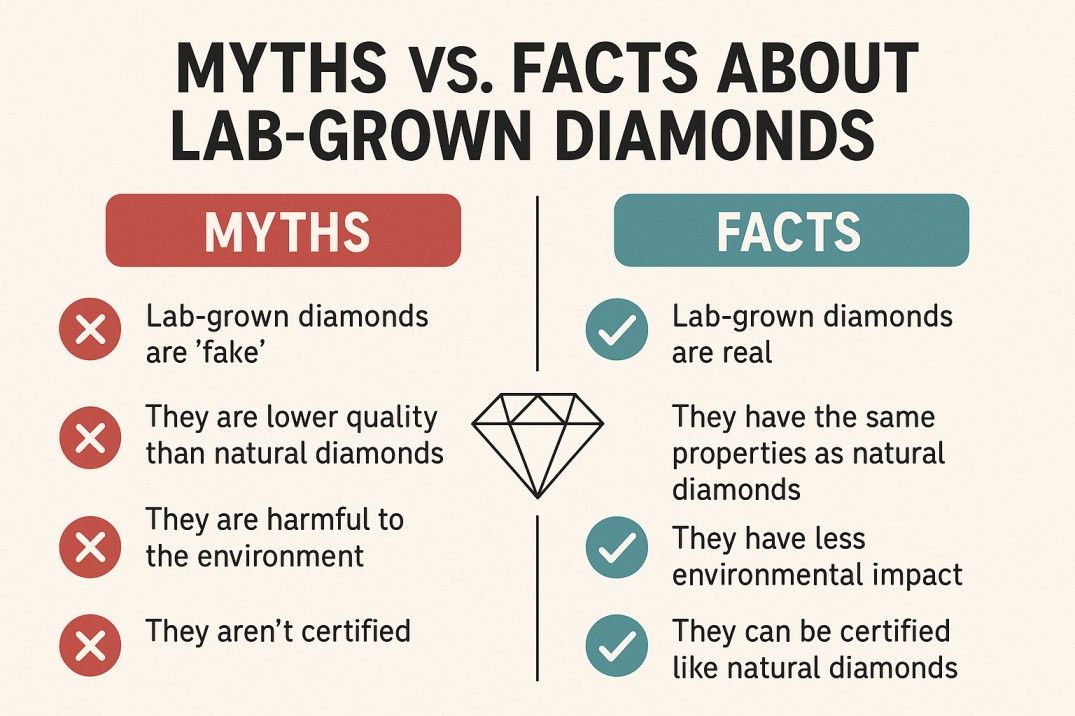Have you ever gazed at a diamond and wondered if it's authentic or lab-grown? You're not the only one. 70% of millennial jewelry shoppers can't distinguish between them, and that's merely the perception.
The concept of lab-grown diamonds might shock you. They're not fakes, they're not cubic zirconia, and they're definitely not cheap glass replicas. They're actual diamonds, atom for atom.
With so much misinformation circulating regarding lab-grown diamonds out there, it's time to cut through the glittering fiction and get to the facts. By the end of reading this article, you'll be clear on what to think next time you're on the diamond hunt.
But first—a heads-up: what if I told you the biggest players in the diamond game have been quietly changing their stance on lab-grown gems?
Understanding Lab-Grown Diamonds: The Science Behind the Sparkle
How are lab diamonds made? The scientific process is described
Ever thought about how these shiny lab gems are made? It's science, not magic!
Lab-grown diamonds are made using two primary processes: High Pressure-High Temperature (HPHT) and Chemical Vapor Deposition (CVD).
In HPHT, manufacturers replicate conditions deep in the Earth's mantle. They place a tiny diamond seed in carbon, then heat it to about 1,500°C and subject it to pressure over 1.5 million pounds per square inch. The carbon is melted and slowly forms around the seed to produce a diamond crystal.
The CVD process differs minimally. Here's how it works: a fragment of diamond seed is placed within a sealed container filled with carbon-rich gas (methane is the most widely used). When scientists heat the container to around 800°C, the gas breaks down and carbon atoms gently rain upon the seed, building the diamond layer by layer—basically, like 3D printing, but cooler.
Chemical and physical properties: same as mined diamonds
Here's the thing that'll blow most people's minds: lab diamonds ARE diamonds.
Identical chemical composition (pure carbon), crystal structure, hardness (10 on the Mohs scale), and optical properties as mined diamonds. Even professional gemologists need special equipment to tell them apart.
The only difference? Their origin story.
Growth timeline: From carbon to finished gem
Growing diamonds isn't a question of overnight success. Growth takes 2-4 weeks for most commercial stone growth.
HPHT diamonds grow faster, taking approximately 2-5 days to grow one carat of rough diamond. CVD diamonds are more patient-inducing, typically taking 2-4 weeks to grow to a similar size.
After they grow, the rough diamonds follow the same route as mined diamonds: cutting, polishing, and grading. From beginning to end, you're looking at 6-10 weeks before that firecracker's on a ring.
Lab-Grown Diamonds Are Environmentally Friendly
Fact: The Environmental Impact Is Lower—But Not Zero
One of the strongest marketing selling points of lab-created diamonds is that they have a lower environmental footprint than mined diamonds. Yes, it's not exactly accurate that they don't blast through tons of dirt or upset ecosystems, but the "eco-friendly" tag can be misleading unless qualified.
Reality:
• Lab-created diamonds consume a lot of energy, especially those made using the High Pressure High Temperature (HPHT) method.
• A few lab diamond manufacturers depend on fossil fuels, while others are transforming to renewable sources of energy to reduce their carbon footprint.
• Revealing an open energy mix is important to understanding a brand's true environmental profile.
Lab-Grown Diamonds Are Ethically Perfect
Fact: They Eliminate Mining Concerns—But Ethical Practices Still Matter
Lab-grown diamonds bypass most of the human rights issues of traditional diamond mining, such as child labor, unsafe working conditions, and supporting conflict.
The Reality:
• Lab-grown diamonds are inherently conflict-free. But working conditions in labs that produce diamonds vary internationally.
• Ethical problems can also exist in terms of workers' rights, factory environments, and power consumption.
Lab-Grown Diamonds Are Inferior Quality
Fact: They're Physically and Chemically Equivalent to Mined Diamonds
Lab-grown diamonds are assumed by some to be "phony" or of inferior quality. Nothing is further from the truth.
The Reality
• Lab-grown diamonds are real diamonds—same carbon content, hardness, brilliance, and fire.
• They can even surpass mined diamonds in clarity and precision since they're cultured within controlled environments.
Shoppers Still Prefer Natural Diamonds
Fact: Values Are Shifting Rapidly, Especially for Younger Buyers
Lab-grown diamonds are typically described as less popular or will not be accepted as engagement ring materials. But shifting values prove otherwise.
Reality
• Increasingly, Gen Zers and Millennials value ethics, affordability, and sustainability over the traditional status symbols.
• Big jewelers like Pandora, Blue Nile, and even De Beers entered the lab-grown business.
• The stigma is fading, and lab-grown diamonds are becoming more mainstream and accepted by society.
Lab-Grown Diamonds Don't Have Any Resale Value
Fact: Resale Value Is Lower—but That's True for Most Diamonds
While resale value is a legitimate consideration, it’s often overstated in critiques of lab-grown diamonds.
The Reality:
• Both mined and lab-grown diamonds typically depreciate once purchased.
• Lab-grown diamonds cost significantly less upfront, so you’re not overpaying.
• The pre-owned lab diamond market is growing, albeit slowly.
Conclusion: Make Informed Choices
Lab-created diamonds offer an irresistible combination of ethics, value, and beauty—but they are not magic gems. Like any market, they involve compromises that the discerning buyer should be aware of. Understanding myths vs. reality enables you to make a decision that addresses your values, lifestyle, and spending limits.
